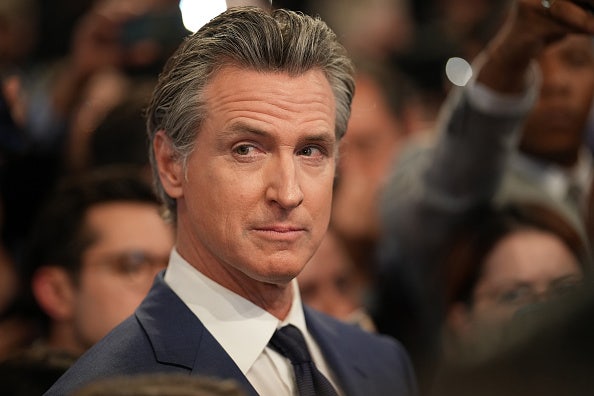New England lobstermen and fishery experts are taking aim at the Biden administration’s latest moves to expand offshore wind energy projects, claiming that they are “rushing” to “political proof” a green energy plan insulated from a possible administration change in November.
The New England Fishermen’s Stewardship Association (NEFSA), a fishing advocacy group that represents wild harvesters in fisheries across New England, filed a public comment on Wednesday with the Bureau of Ocean Energy Management (BOEM) opposing the agency’s recently unveiled plans to lease 2 million acres of ocean for offshore wind development. It’s an unprecedented leasing area that would allot for construction of enough wind turbines to produce 32 gigawatts (GW) of energy.
NEFSA, along with Responsible Offshore Development Alliance (RODA), say the administration’s plans are detrimental to the commercial fishing industry and marine life in the Gulf of Maine.
They also say the plans are rushed and being constructed in such a way as to insulate them from a future administration that might not wish to make such wind energy investments.
HOW MAINE LOBSTERMEN TURNED ‘SLAP IN THE FACE’ FROM WHITE HOUSE INTO POLICY VICTORY
New England lobstermen and fishery experts are taking aim at the Biden administration’s latest moves to expand offshore wind energy projects. (AP Photo/Robert F. Bukaty, File)
“This really looks like a way to keep this process moving forward and to provide some insulation against potential political changes, for this administration to hit its goals, but there’s nothing about it that makes sense,”Annie Hawkins of RODA said Monday.
BOEM, an agency within the Department of Interior, announced last month its finalization of the wind energy area (WEA) lease. BOEM boasted that the Gulf of Maine WEA surpasses the current state goals for offshore wind energy in the Gulf of Maine –10 GW for Massachusetts and 3 GW for Maine.
In a public comment to BOEM’s Notice of Intent to Prepare an Environmental Assessment in the Gulf of Maine WEA, NEFSA urged the agency to consider the extent to which WEA “in its current form will have tremendously deleterious effects on the safety and well-being of the men and women who operate in the commercial fishing industry.”
“These hazardous effects are a direct result of the deficient and incomplete data upon which BOEM relied, and the deficiencies in BOEM’s data is a direct result of the Agency’s decision not to consult with representatives from the commercial fishing industry before drawing its conclusions,” the comment states.
MAINE LOBSTERMEN CATCH BIG COURT VICTORY AGAINST BIDEN ADMINISTRATION’S ‘EGREGIOUS’ REGULATIONS
Three wind turbines stand in the water off Block Island, Rhode Island, the nation’s first offshore wind farm, on Aug. 15, 2016. (AP Photo/Michael Dwyer, File)
One large portion of the WEA is frequented by the endangered North Atlantic right whale, the groups said, with 16 right whales observed in the area in just one day during the 2024 winter season. “Given the perilously low number of Right Whales left in existence, this area should have been removed from the final Wind Energy Area,” the group states.
NEFSA also alleged that BOEM’s failure to consider the effects of wind farms on fish species and surface temperatures present dangerous environmental and economic consequences for the New England area.
“Wind farms cause an increase in ocean surface temperatures and emit electromagnetic fields (EMFs). There is a wholesale lack of research documenting the effects of windmill heated water and EMFs on fish stocks, specifically bluefin tuna,” NEFSA claimed.
The group claims that some research has shown that EMFs produced by sea cables “could have a 5 measurable impact on early development of two commercially important crustaceans.”
“The adverse effects of EMFs – which 7 BOEM has failed to address – could disrupt and decimate fish populations in the New England area,” NEFSA stated in its comment.
According to NEFSA, BOEM has also failed to consider “the adverse effects of wind farms on sea surface temperatures and climate change.”
BIDEN ADMINISTRATION BLASTED FOR ‘HYPOCRISY’ ON OFFSHORE WIND AS IT SCRAMBLES TO PROBE WHALE DEATHS
Maine lobstermen haul in their catch off the state’s coast. (Maine Lobstermens Association/Marketing Collaborative)
“Wind farms cause an increase in sea surface temperatures and disrupt upper-ocean hydrodynamics in ways that remain incompletely understood by scientists,” NEFSA said.
The mixing of the ocean surface layer is predominantly driven by shear, so “anomalies in the wind field can have severe consequences for the upper ocean dynamics,” as noted in a 2022 study in “Frontiers of Marine Science.”
NEFSA claims that BOEM’s sister agency, the National Oceanic and Atmospheric Administration (NOAA), which provided data to BOEM for its WEA assessments, has at various times “admitted that they have no baseline data – indeed, very little data at all – on habitats in the Gulf of Maine.”
“And what little data they have was furnished by observers with little to no at-sea experience on commercial vessels.”
“They have little to no sampling data collected, and the high turnover rate for NOAA personnel is an example of improperly vetted observers,” NEFSA states in its comment.
“Taken together, the inescapable conclusion is that, insofar as BOEM has relied on the faulty information that it has received from NOAA, BOEM does not have the information it needs to accurately assess the impact that will be inflicted on the men, women, and sea life by its Wind Energy Area,” the group claims.
Wind turbines generate electricity at the Block Island Wind Farm on July 7, 2022, near Block Island, Rhode Island. (John Moore/Getty Images)
BOEM said the Gulf of Maine WEA was finalized in support of the Biden-Harris administration’s goals for deploying 30 gigawatts (GW) of offshore wind energy capacity by 2030.
BOEM told Fox News Digital that they will conduct a “phased leasing approach, and that BOEM does not intend to lease the entire final WEA, rather, but rather BOEM will now consider proposed lease areas from within the final WEA based on certain criteria.”
They said the WEA was finalized “after extensive engagement with lobster fishermen in fishing communities” and “avoids several other important fishing areas and habitats, including important groundfish areas.”
But Annie Hawkins, whose group aims to coordinate with regulatory agencies to help install policy that minimizes conflicts with existing traditional and historical fishing, says there’s no “transparent process” in place by BOEM in an effort to whittle down the massive WEA, and no specific criteria as it relates to the fishing industry.
“It’s really clear that they are rushing to get some lease on paper before the end of this administration. It’s very clear that they are, by making this designation, they’re making it sort of, political proof, so that in the future, if the administration changes… that is [not] favorable to wind leasing… it makes it just a lot easier to keep moving forward,” Hawkins said.
“We will see the effects of it and the effects will not easily be reversed,” Maine lobsterman and NEFSA member Jason Joyce, said Monday.
“I’m afraid that the effects will be pretty darn permanent… it’s just it’s all just so destructive,” he said.
Brianna Herlihy is a politics writer for Fox News Digital.




